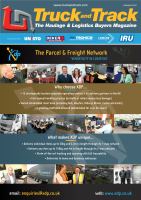
 www.truckandtrack.com
www.truckandtrack.com
June/July 2017
Truck and Track
51
SAFETY & SECURITY
who could undermine the logistics system and allow terrorists to
take advantage of breaches.
Once security seals have been delivered, keep them under lock
and key and issue them under control, together with the manifest,
to a supervisor or manager. Several features make a security seal
unique:
■■
The make and type of seal (ISO17712 seal manufacturers will
have their company name discretely blind-embossed into the
seal somewhere: it’s a stipulation to provide traceability back to
the source of the seal).
■■
Its colour.
■■
Its markings.
■■
Its numbering / barcoding.
All of these details together make a seal
unique, and they all need recording.
Sometimes colours can be used for
logistical control, say blue for
Outbound
,
green for
Inbound
, red for
Returns
. Markings
can include your logo or simply the word
“SEALED” or “SECURED”. Do bear in mind
that, if you decide to incorporate your own
logo, delivery lead-times may increase to
allow for that.
Numbers can either be issued in sequence
or randomised – there are arguments for
each methodology. Sequential issuing
can allow the dishonest to plan ahead to
substitute an alternative seal, since they
know the range of numbers in advance. The
larger the fleet, the more difficult it is to
predict the next number that will be issued
to a particular vehicle.
Barcoding is of course a great way to
avoid transcription errors or the vagaries
of handwriting, with automatic data
capture ruling out the chance of number
manipulation.
The driver should not be responsible for
sealing at the outset or breaking the seal at destination. Before the
seal is applied or broken by the manager or supervisor, it should be
checked against the manifest. These days, with the ease of digital
smartphone photography, some companies have taken to emailing
an image of the seal to destination, in order to prevent substitution
en route of a different seal with the same number.
Before the seal is removed from the door, check that the seal is in its
original state, i.e. it hasn’t been removed and reapplied in transit. A
quick tug will establish that it has its original strength and hasn’t
been glued or heat-welded. Then check the numbers have not been
altered or deliberately obscured.
Another check is to ensure that the seal is actually preventing the
door from being opened. There are methods of false sealing that
at first glance look convincing, but in such a case the seal does not
prevent the latch being lifted and the door opened.
The broken seal can be kept with the consignment paperwork for
future investigation, in case of any discrepancy when reconciling
the delivery, and only afterwards disposed of securely.
This is an important point! Often when visiting an industrial estate
you see spent seals littering the roadway and loading areas. That
is not only unsightly litter, but also offering the opportunity for the
unscrupulous to harvest seals that can be used to substitute other
ones or learn how to tamper with them.
A security seal is only as good as the regime put in place to control
and monitor it!
Seal management needs to be a formal, written procedure which
is strictly followed, so that it becomes an automatic routine. Seal
tampering and dishonesty are rare within a well-run, security-
conscious business. However, within a flaky regime, dishonesty can
flourishandbecome a costly andmorale-sapping issue, threatening
the viability and future of the company itself.
www.unisto.co.ukHi-Genius
Integer polypropylene ring seal
on curtainsider
Fixlock
Blue H seal
Variflex
”



















